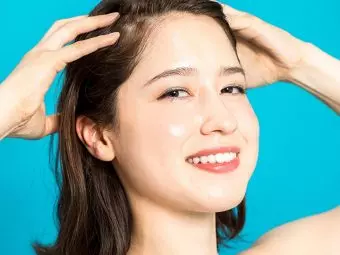It is needless to say that our hair defines our look, at least to some extent. A good hair density is what everyone wishes to have, be it a man or a woman.
Is hair density and hair thickness are the same? If not, how do they differ? This article answers all these queries besides looking into the reasons behind low hair density, how to increase it, and if shaving the hair helps in this regard. Let us get started.
In This Article
What Is Hair Density?
Hair density refers to the number of strands that grow per square inch on your scalp. It can vary during your life, changing over the course of years and through adulthood.
Before you jump to find out how to determine hair density, note that the human head has more than 100,000 strands of hair on average (1).
Seeing the sheer amount of strands on the human head, it must be tempting to know what your hair density is. Find out how you can measure your hair density below.
Is There A Way To Measure Hair Density?
Accurate measurement of the density of your hair requires help and technical intervention. Even then, the determined density is not permanent. Since the different areas of your scalp exhibit varied characteristics, the density may differ (2).
The two most seemingly accessible ways that can help you measure hair density are:
1. Count
This method is more of an estimate rather than a tiresome activity. Simply count the number of strands on a square inch patch of your scalp and multiply it by the number of square inches on your scalp. Note that the average number of strands of hair on one square inch of scalp varies between 124 and 200 (3).
2. Scalp Visual
Counting can be quite time-consuming, so another way to determine your hair density is by looking at your scalp.
- If you can see your scalp easily, you can assume that it has a low hair density.
- If you can see your scalp, but not too clearly, you may assume it to be medium hair density.
- If it is hard to spot your scalp, consider it to have high hair density.
The above-mentioned methods are not absolute, nor are they the gold standard. For accurate calculations, clinical aestheticians and doctors use computerized methods, involving a dermatoscope which are also being improved for efficiency.
If you find that you have low hair density, it will be beneficial to know its reasons.
What Are The Reasons Behind Low Hair Density?
The human body is made up of numerous chemical combinations. Each characteristic is attained naturally, and some are acquired from the environment you grow in. A few of the most common causes of low hair density are:
1. Genetics
Genes determine various components of your hair, skin, and body – right from your skin color to the pigments in your hair. If your parents had finer and less dense hair, chances are you will too. If they had a denser growth, you are more likely to as well.
2. Age
It is natural for your hair growth to reduce with age. Multiple studies have found that hair density peaks at around 27 years and begins to decrease after the mid-thirties. As you grow older, your hair follicles – which are the roots of hair strands – slow down in their cycles of growing new hair every time it falls. Eventually, they stop growing new hair altogether (4).
3. Hormones
Hormonal imbalances caused by hypothyroidism, hyperthyroidism, PCOS, and other health conditions are commonly known to cause hair loss (5).
4. Nutrition
A healthy diet is essential for healthy-looking hair and skin. Deficiencies in vitamins and minerals can show up as changes in your scalp, which can cause hair loss (6).
5. Damage
Low hair density can occur due to improper handling of hair. This is also known as trauma alopecia. Hairdos that constantly pull your locks, harsh chemical relaxers and treatments, and exposure to high heat from styling tools can affect your hair density (5).
6. Stress
Stress has been known to induce hair loss. Thankfully, this is usually temporary, and normal hair growth continues with a new cycle. The only solution to this is stress management (7).
7. Side Effects Of Medication
Many drugs, such as cancer drugs, immunosuppressants, and beta-blockers, list hair loss as a side effect. Though not everyone experiences these side effects, if you notice a change in hair density after taking these medications, consult your physician about it (8).
Now that you are familiar with the causes and the exact meaning of hair density, you can try the right products and hairstyles that bring out your best! Below are some styling tips for people with different hair densities.
Styling Tips According To Hair Density
- Low Hair Density
Go for haircuts like bobs and layers. These create an illusion of a fuller and a larger crown of hair. Also, when styling your hair, tease the roots to puff it up further. Use volumizing shampoos and ditch any chemical-rich serums and hair products. They can weigh your hair down, giving it a thinner look.
- Medium Hair Density
You can experiment with different hairstyles as your hair does not fall at either end of the spectrum. Based on how you choose to style your locks, you can use products that protect them from further damage.
- High Hair Density
Low layers and ’slicing’ haircuts work well for you. For you, choosing the right cut can be a little tricky. Your hair texture also makes a difference as curls are more likely to look larger if cut too short. Use products that weigh your hair down and nourish it well.
While knowing your hair density while picking a suitable hairstyle matters, knowing if your hair is thick is different. We assess the difference between hair density and hair thickness below.
Difference Between Hair Density And Hair Thickness
Hair thickness refers to the size of a strand in terms of diameter, which correlates to the size of the hair root or follicle. On the other hand, hair density is the number of hair strands on your head.
Subscribe
The thickness of your hair does not make a discernable impact on your overall appearance, but hair density does. As such, you should focus on increasing your hair density for a thicker, fuller crown.
Here are some ways to combat sparse hair growth and get high-density hair.
How Can You Increase The Density Of Your Hair?
1. Platelet-Rich Plasma (PRP) Treatment
In this treatment, platelet-rich plasma is derived from your blood and injected into specific areas of your scalp. This stimulates hair growth and reduces inflammation. The platelets contribute to hair growth as they are said to be rich in proteins (9).
2. Low Light (LLLT)
For this, red light therapy and cold laser are used to stimulate hair growth. This method is more convenient and claimed to have lower adverse effects than long-term evasive procedures (10).
3. Nutritional Supplements
Since poor nutrition plays a role in hair loss, you should take supplements if you do not hit the required daily intake for various nutrients and minerals. Supplements of omega 3 and 6 fatty acids have shown an improvement in hair quality and perceived growth (11). You can also consume amino acid and protein supplements.
If you feel that your hair density has reduced, consult your doctor about the above methods and pick one that suits your requirement. You can also refer to a hair density chart for more efficient results.
What Is A Hair Density Chart?
If the methods mentioned above require too much of an effort, you can always switch to weaves. Weaves are hair extensions that add to the volume and length of your hair.
To figure out which weave suits you, you may refer to the hair density chart based on a standardized system, as listed below:
- 50% – Very thin and sparse. This is usually recommended for older people.
- 80% – A low hair density weave that shows the scalp easily.
- 100% – Most commonly selected and gives a natural look and feel.
- 120% – Slightly more than the natural look that is becoming increasingly popular.
- 130% – A moderate-density weave suited for people in their mid-20s.
- 150% – This is a highly dense weave and not commonly selected.
- 180% – Extremely dense; most weave makers do not recommend this unless required.
Not interested in a weave? Are you more inclined to conventional methods like shaving off your hair? Read on to know more about shaving your head to increase your hair density.
Can Shaving Your Hair Actually Increase Its Density?
The belief that hair density can improve if you shave your head is a myth! It merely gives that effect as the blunt (thick) ends of your hair start growing again from the roots. Shaving can give your locks a better feel, but do not be fooled. This is only because the new hair that grows is not as damaged from environmental exposure.
More importantly, shaving your hair cannot help with thickness. Hair thickness depends on the shaft composition and follicle size. Therefore, shaving your hair is not the best solution for low-density natural hair.
The human head has more than 100,000 strands. To check your hair density, you can either count the number of strands per square inch or check to see if you can see your scalp easily. If you have low density, it may be due to genetics, stress, or hormonal imbalance. You can try different looks and the right products to style your hair according to your hair density. You can also opt for medical treatment such as platelet-rich plasma therapy or nutritional supplements for increasing your hair density.
Frequently Asked Questions
Is thick hair healthy?
Thick hair does not necessarily mean healthy hair. In fact, thick hair can be more prone to breakage.
Does thin hair mean balding?
Thin hair does not necessarily mean that you are balding. However, the lower volume of hair does give the appearance of baldness.
Key Takeaways
- You can simply determine your hair density by looking at your scalp or counting the number of strands on a square inch of your scalp.
- Genetics, age, hormones, stress, and nutrition can impact hair density.
- Hair thickness and hair density are two different things, and you can style your hair based on your hair density.
Sources
Stylecraze has strict sourcing guidelines and relies on peer-reviewed studies, academic research institutions, and medical associations. We avoid using tertiary references. You can learn more about how we ensure our content is accurate and current by reading our editorial policy.
- Number of hairs on human head
https://bionumbers.hms.harvard.edu/bionumber.aspx?id=101509 - Parietal scalp is another affected area in female pattern hair loss: an analysis of hair density and hair diameter
https://www.ncbi.nlm.nih.gov/pmc/articles/PMC5749551/ - Distribution of human hair in follicular units. A mathematical model for estimating the donor size in follicular unit transplantation
https://pubmed.ncbi.nlm.nih.gov/10417585/ - The psychological and aesthetic impact of age‐related hair changes in females
https://onlinelibrary.wiley.com/doi/abs/10.1111/jocd.12960 - Hair Loss
https://www.health.harvard.edu/a_to_z/hair-loss-a-to-z - Nutrition and hair
https://www.sciencedirect.com/science/article/abs/pii/S0738081X10000623 - Hair and stress: A pilot study of hair and cytokine balance alteration in healthy young women under major exam stress
https://www.ncbi.nlm.nih.gov/pmc/articles/PMC5397031/ - Drug that Causes Hair Loss and Promotes Hair Growth-A Review
https://www.researchgate.net/publication/300852952_Drug_that_Causes_Hair_Loss_and_Promotes_Hair_Growth-A_Review - The Effect of Platelet-Rich Plasma in Hair Regrowth: A Randomized Placebo-Controlled Trial
https://www.ncbi.nlm.nih.gov/pmc/articles/PMC4622412/ - Low-Level Laser (Light) Therapy (LLLT) for Treatment of Hair Loss
https://www.ncbi.nlm.nih.gov/pmc/articles/PMC3944668/ - Effect of a nutritional supplement on hair loss in women
https://onlinelibrary.wiley.com/doi/abs/10.1111/jocd.12127
Related
The following two tabs change content below.
- Author
- Reviewer

Arshiya Syeda
Arshiya Syeda is an editor at StyleCraze. Prior to that, she was a content writer and combined her writing and… more
Dr. Shruti Chavan
(MBBS)Dr. Shruti Chavan is a consulting dermatologist at Dr.Sheth’s Skin and Hair Clinic since 6 years. She is a co-committee… more



 How To Use Jamaican Black Castor Oil For Hair Growth
How To Use Jamaican Black Castor Oil For Hair Growth How To Exfoliate Your Scalp At Home To Clear Excess Oil
How To Exfoliate Your Scalp At Home To Clear Excess Oil How To Apply Oil On Hair: A Step-By-Step Guide
How To Apply Oil On Hair: A Step-By-Step Guide How To Use Coconut Oil For Dry Scalp And Dandruff
How To Use Coconut Oil For Dry Scalp And Dandruff Easy Way To Get The Perfect Twist Out On 4C Natural Hair
Easy Way To Get The Perfect Twist Out On 4C Natural Hair Eyebrow Hair Loss: Causes, Prevention Tips, & DIY Methods
Eyebrow Hair Loss: Causes, Prevention Tips, & DIY Methods Types Of Hair Loss, Causes, Treatments, & Prevention Options
Types Of Hair Loss, Causes, Treatments, & Prevention Options Itchy Scalp And Hair Loss: How To Treat And How To Prevent It
Itchy Scalp And Hair Loss: How To Treat And How To Prevent It What Is Hair Texturizing? How To Take Care Of Texturized Hair?
What Is Hair Texturizing? How To Take Care Of Texturized Hair?